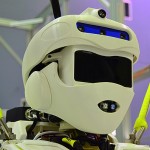
Recently it seems that most roboticists focus on making bipedal robots, probably in an attempt to create reflections of themselves. Oregon State University’s ATRIAS, on the other hand, while a bipedal robot, it doesn’t exactly have humanoid features.
ATRIAS has nothing on Ultron (nor Pinocchio), as it still has some strings on it, sign that its creators are not yet ready to set it free into the wild. Not long ago, the bipedal robot developed by the Dynamic Robotics Laboratory at Oregon State University, directed by Dr. Jonathan Hurst, got to make its first steps in a controlled environment. Taking it for a walk in the park (I wouldn’t want to think of robots as pets, but that is how this sounds) is a completely different thing, but ATRIAS still doesn’t pose a threat to humanity, as it’s watched at all times by its makers.
While this is far from being the best looking bipedal robot, its walking skills and the way it handles variations in terrain might cause other roboticists to get green with envy. People who have read the news about ATRIAS claim it has a horrible design, but they fail to see beyond the looks, as it’s functionality that really matters in this case.
As demonstrated in the following video, ATRIAS can easily walk downhill or uphill, but can also maintain balance while projectiles are thrown at its legs. All of these actions (and hopefully more) will be exhibited at DARPA Robotics Challenge next month. Needless to say, it will have to face some tough competition, and while it’s a bit unlikely that it will emerge victorious, it’s still a great attempt.
Hopefully, the team that created this bipedal robot won’t stop here, and will continue to add features and functionality to it. The design is not that important, but tweaking it a bit wouldn’t hurt, either. After all, if the roboticists behind ATRIAS are looking to please everyone, they’ll need to take this into consideration, as well.
Instead of conclusion, I would like to show you the message posted by Oregon State DRL on YouTube, as a comment to the above video: “I walked outside for the very first time. #Robots don’t get emotional about these things, though… sniff #Robotics”
Be social! Follow Walyou on Facebook and Twitter, and read more related stories about the bipedal robot that displays an incredible sense of balance, or IHMC Robotics’ ATLAS, a bipedal robot who knows karate.

 Most of the teams who took part in last year’s DARPA Robotics Challenge (DRC) explained how their robots would look …
Most of the teams who took part in last year’s DARPA Robotics Challenge (DRC) explained how their robots would look …
